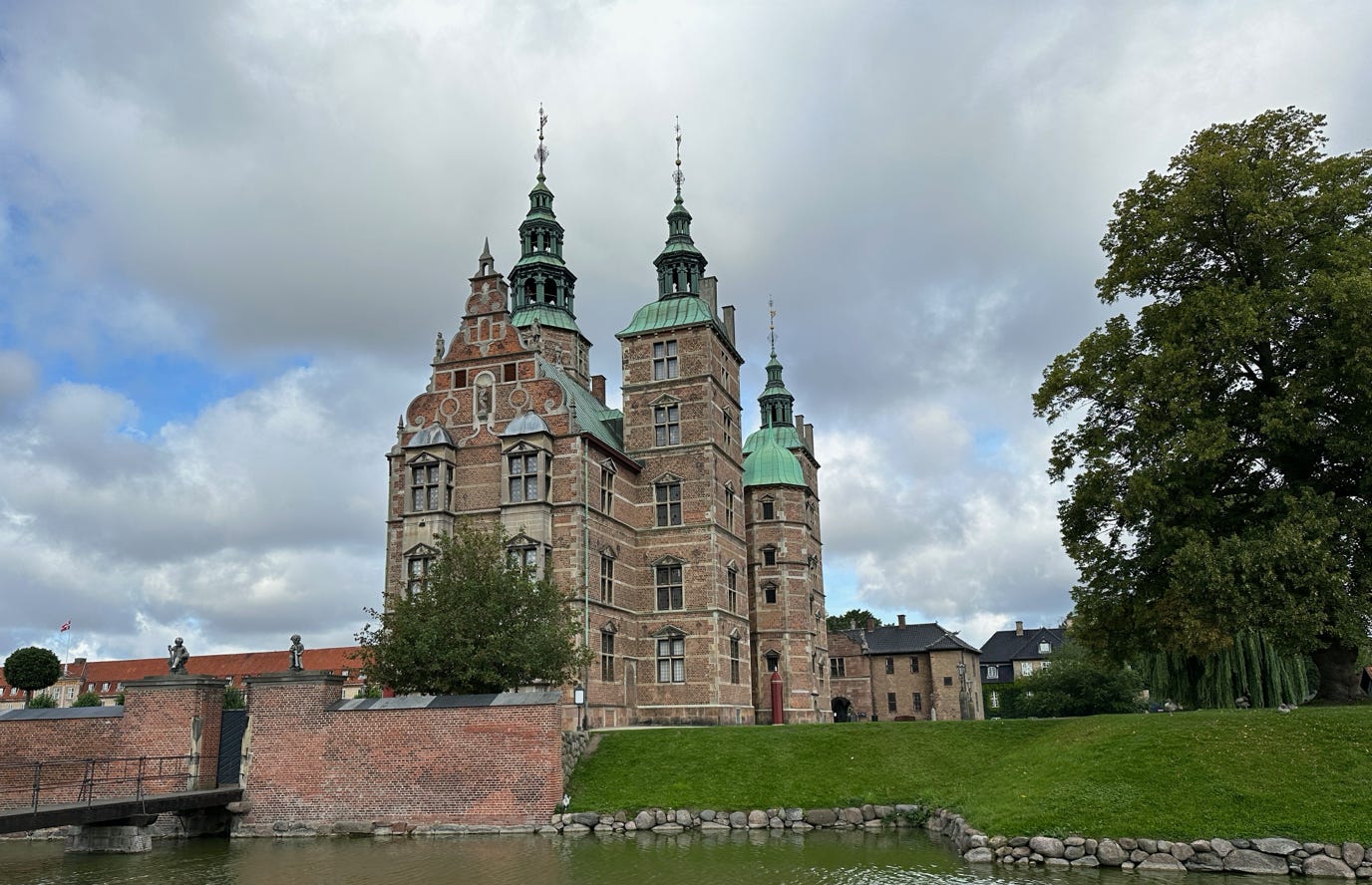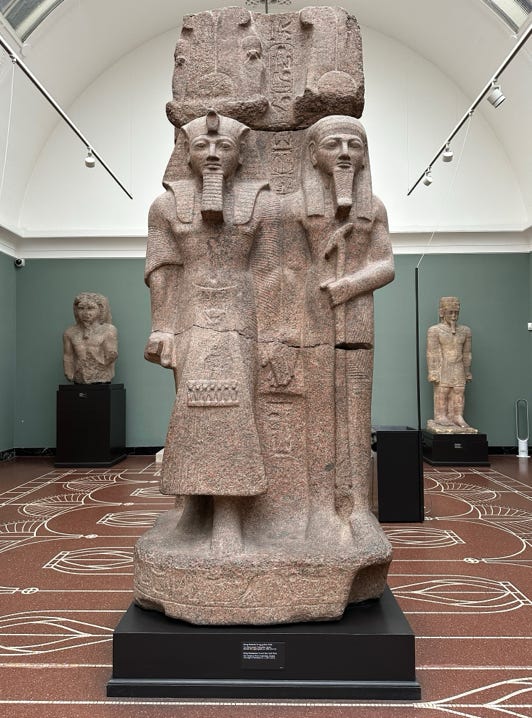
More Copenhagen
and travels homeward
24 August 2023
We walked north of the hotel to the King’s Garden and then to Rosenborg Castle. It is similar in architecture and age with the Frederiksborg castle we saw yesterday, although it boasts more original furnishings—it doesn’t seem to have suffered from fires over the centuries. The basement of the castle houses the Danish Crown Jewels, which are a much larger collection than the Swedish Crown Jewels we saw in Stockholm. Again, much gold. Also, we have observed in both Sweden and Denmark a surprising fascination with elephants.







Crests for two of the three Scandinavian crowns.


Two examples of artifacts with elephants.
We then walked to the Nyhaven (New Harbor) District, with its colorful houses and boats along a canal. We took a one hour boat tour from which we saw the Opera House, the famous Little Mermaid statue, Christianshavn, the Royal Danish National Theater and the “Black Diamond” Library.


A nice square above, and two views of Nyhavn, below with a tour boat like the one we took.

Below are photos from the boat trip, from top, the opera house, the Royal Danish Playhouse building, the “black diamond” library and the Church of Our Savior’s spiral tower.




After having lunch in Nyhavn, we walked through the Amalienborg (by chance witnessing a changing of the guard) to the Design Museum Denmark. This museum has interesting exhibits of Danish design, including a nice video made in the 1960s giving insight into the development of 20th the Century Danish furniture with which we are all familiar. We then returned to the hotel to rest up a bit before heading to Tivoli Gardens for the evening.
In the early evening, we walked about 15 minutes to get to Tivoli’s main entrance, where we strolled inside Tivoli for a bit over an hour, watched people on the rides and admired the attractive gardens. We were surprised to learn that Tivoli dates from 1843! Of course, the carnival rides have changed a great deal in that time, we think. We ate dinner in one of the restaurants in the park, and it evoked a glass-covered beer hall. After dinner we strolled a bit more, admired the lights and caught a bit of a performance on an outdoor stage before walking back to our hotel.


Amelienborg, the Marble Church and the changing of the guard. Below are some photos from our time at Tivoli.





25 August 2023
We took a train from Nørreport Station (near our hotel) about 20 miles to the historic capital of Denmark, Roskilde. We walked about a quarter of an hour to the city’s red brick cathedral with its twin, very tall spires. The cathedral is a UNESCO site and has, for 500 or more years, been the burial site for Danish royalty.

Below are photos from the church interior.




We then walked down to the seashore to visit the Viking Ship Museum with its remains of five Viking ships from the mid–eleventh century. These were excavated and restored from 1962 until the museum opened in 1993. We watched an interesting video about the history of the Vikings and their sailing exploits as well as the recovery of the five ships. The Museum also has built working replicas of the historic ships using Viking methods. They sailed one of these replicas to Dublin, Ireland and back. We ate lunch in the museum’s cafe, which serves only foods from the Viking era (e.g. no potatoes, tomatoes, peppers, etc.). After viewing the outdoor exhibits, we took a bus back to the Roskilde train station and the train back to Copenhagen.




Top left, a replica ship. Bottom right, replica ships sailing.
The other two photos show the ships inside the museum.
From the Copenhagen Central Station we walked to “Radhuset,” the City Hall. It was built around the turn of the 20th century and has the wonderful Jensen’s World Clock on display. The building was quite attractive, but of course, did not compare to the amazing Stockholm city hall we had seen last week. Photos below of the plaza, façade detail, the interior and the world clock.




We then took a bus to the Cristianshavn neighborhood, across the Inderhavnen (inner harbor) from the center of Copenhagen. We took a brief walk into the commune of Christiania. The famous “pusher” street is just that, an open air market for drugs, as well as merchants who would be at home on Telegraph Avenue in Berkeley.


We found the “Green George” by the sculptor Thomas Dambo, above right, located in Christiania and then walked from Christiania to the Church of Our Savior. We looked at the wonderful vertigo-inducing exterior 400 step staircase and decided climbing it was not for us. Here’s a photo of the church’s organ.

Then we walked to the Circle Bridge, which we saw yesterday from the tour boat. From there, we took another pedestrian bridge across the inner harbor to the Danish Architecture Center. The exhibits in this museum are quite interesting about the history and importance of Denmark’s architects (including the builder of Sydney’s famous Opera House) and architecture. We thought this museum was quite well done. Here’s a photo from the museum.

And here are some photos from our walk, including people having a good time, the Circle Bridge and a view of the main canal.



We then returned to our hotel through the central shopping district. Today was another day when we walked well more than 8 miles.
26 August 2023
We got a leisurely start and strolled to the Ny Carlesberg Glyptoteket. This is a private museum exhibiting the collections amassed by the founders of Carlsberg Breweries. It has a nice collection of antiquities from Egypt, Rome and other civilizations, including three Babylonian friezes. The Museum also has a collection of Danish paintings and a very fine array of French impressionist paintings. Here are Egyptian, Roman and Babylonian works. Check out the detail on the Roman soldier.



We then walked through the Slotsholmen neighborhood to the Black Diamond Library (part of the Royal Library). On the way we encountered many participants in a local swimming event. We explored the interior of the Black Diamond with its stupendous views and got a peek into the old reading room (which looked a lot like Doe Library at UC Berkely). Here are two photos, one from the library along with one of swimmers.


We then had a canal-side lunch before continuing by train and bus to the suburban art museum of Ordrupgaard located near Jægersborg Dyrehave. We toured its permanent collection of Danish and French art, including more impressionists, but we especially enjoyed the special exhibit of Jesper Christiansen, a contemporary artist with whom we were not familiar (photo below). After viewing the inside, we walked around the outside of the museum to examine the Hadid–designed wing and the site–specific art installations, but there was construction work underway that made it difficult to see most of the sculptures. We then headed back to Copenhagen, again via bus to the Klampenborg Station, and then train back to Nørreport.

27 August 2023
We left the hotel and walked again in the direction of Rosenberg Castle to the SMK (Statens Museum for Kunst), the state art gallery. The museum has a very large collection of paintings (mostly) and sculptures from 1300 AD to the present. There are some famous names sprinkled about, including Rembrandt, Cranach and Munch. There is a fairly large collection of 20th Century Danish artists which we found interesting.

A painting in SMK by Danish
artist Richard Mortensen.
After that, we went back to the Torvehallerne Food Hall to have lunch. Afterward, we walked around the area near our hotel, stopping to have a last Danish cake, until we took a taxi to the airport for an evening flight to Munich, where we spent the night at an airport hotel. From there, we will catch a connection tomorrow morning to San Francisco. Here’s one last photo of the mayor of Zurich speaking to a group outside the food hall to conclude the “Copenhagen Cooking” festival.

Here’s the routing for our flights home, a distance of more than 6,300 miles.

We immensely enjoyed our travels to Sweden and Denmark. Both capital cities have beautiful palaces and churches, plus interesting museums. We learned about European history with which we were not as familiar as other regions, and were surprised by the historical, as well as current, wealth of the kingdoms. We found everyone spoke English, the transportation systems were mostly easy to use and the food was by and large quite good (although expensive compared to other places we have visited). We enjoyed the introduction to local art, as well as the modern architecture and design. All in all, an excellent trip.
